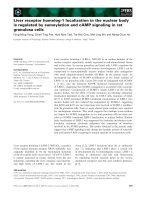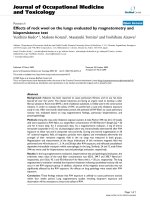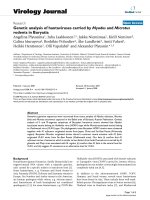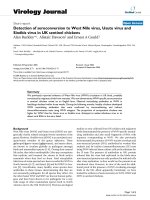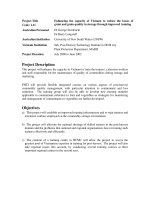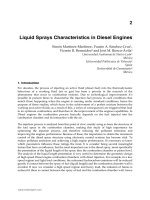Ionic liquid catalysis to produce cottonseed oil by transesterification and performance test in diesel engine
Bạn đang xem bản rút gọn của tài liệu. Xem và tải ngay bản đầy đủ của tài liệu tại đây (340.18 KB, 8 trang )
International Journal of Mechanical Engineering and Technology (IJMET)
Volume 11, Issue 2, February 2020, pp. 73-80, Article ID: IJMET_11_02_007
Available online at />ISSN Print: 0976-6340 and ISSN Online: 0976-6359
© IAEME Publication
IONIC LIQUID CATALYSIS TO PRODUCE
COTTONSEED OIL BY
TRANSESTERIFICATION AND PERFORMANCE
TEST IN DIESEL ENGINE
Dr. M. Udaya Kumar
Professor, Department of Mechanical Engineering
Indur Institute of Engineering and Technology, Siddipet, Telengana, India
N. Sivaramakrishnan
Assistant Professor Department of Mechanical Engineering,
Indur Institute of Engineering and Technology, Siddipet, Telengana, India
ABSTRACT
This work is based on the performance of biodiesel blends with diesel in providing
for a suitable alternative fuel. There are various methods in which the biodiesel blends
are made. Every approach uses the preparation of biofuel initially from a parent oil
blend. Here cottonseed oil is taken to make biodiesel. For the conversion ionic liquids
have been used as catalysts. The process of transesterification has shorter reaction
times with ionic liquid usage. Then subsequently test is made on a diesel engine
particularly suited for alternative fuels to find out the biodiesel performance. All the
tests to find the suitability of the transesterified biofuel for use in a diesel engine have
been done and results presented. The performance graphs show B30 to be the
optimum based biofuel blend for which maximum efficiency has been found.
Keywords: Hybrid wind turbine, Vertical axis wind turbine, Low wind speed.
Cite this Article: Dr. M. Udaya Kumar and N. Sivaramakrishnan, Ionic Liquid
Catalysis to Produce Cottonseed Oil by Transesterification and Performance Test in
Diesel Engine. International Journal of Mechanical Engineering and Technology
11(2), 2020, pp. 73-80.
/>
1. INTRODUCTION
Reserves shortage and price fluctuation along with emitted pollutants like tetra hydrocarbons
are causing a ever growing substitution of fossil fuels with fuels derived from vegetable oil
such as biodiesel. Biodiesel production mainly is the process of producing the biofuel,
biodiesel through the chemical reactions transesterification and esterification.
This involves vegetable or animal fats and oils being reacted with shortchain alcohols like
methanol. Greater conversions into biodiesel can be reached using methanol because of short
chain structure. Although the transesterification reaction can be catalyzed by either acids or
/>
73
Dr. M. Udaya Kumar and N. Sivaramakrishnan
bases the most common means of production is base catalyzed transesterification because of
high yields possible. This path has lower reaction times and catalyst cost than those posed by
acid catalysts and this is a major advantage. The reason for using catalyst is to speed up the
conversion process to suit the parent oil as well as to increase the yield.
Animal fats and plant oils are made up of triglycerides which are esters formed by the
reactions of three free fatty acids and the trihydric alcohol and glycerol. In the
transesterification process, the added alcohol is deprotonated with a base to make it a stronger
nucleophile which later decomposes. The reactions have no other inputs than the triglyceride
and the alcohol and this is sufficient to cause the reaction. Under normal conditions, this
reaction will proceed either Exceedingly slowly or not at all, so heat as well as catalysts are
used to speed the reaction and also to increase the yield. The acid or base catalysts are not
consumed by the transesterification reaction. Common catalyst for transesterification include
sodium hydroxide or even ionic liquids. The biosource used in this project for producing
biodiesel is cottonseed oil. Cottonseed oil is extracted from the seeds of cotton plants of
various species. Its fatty acid profile consists of 70% unsaturated fatty acids and 26%
saturated fatty acids.
2. METHOD OF EXTRACTION OF COTTONSEED OIL
The process of extraction of cottonseed oil is by using SCF ie Supercritical fluid. The fluid
used usually is carbon dioxide. Dehulled cottonseed is passed through cracking and flaking
rolls to yield flakes. The flaked cottonseed is charged into an alloy steel autoclave and
extracted. The process may be mechanical as in crushing or pressing or chemical as in solvent
extraction. The production steps are as follows.
Seed cleaning
Cracking
Flaking
Cooking
Expelling
Refining
Seed Cleaning
This process involves getting rid of organic impurity like stems, leaves, hull, rope etc,
inorganic impurity like dust, silt, pebbles and metals, oiliness impurity like grain of insects,
grain of faultiness, heterogeneity seeds etc. Magnetic Separator, Vibrating Sieve, De-stoner,
Decorticator are used in the process.
Cracking
Toothed cracking rollers are used to convert the cotton seeds kernel into right uniform pieces
which can keep a moderate block size for squeezing out the oil.
Flaking
This process converts the cracked cotton seeds kernel pieces into uniform smaller flakes. The
non oil spilled pinching is done slowly. The pieces are passed through sieve mesh to separate
the powder.
/>
74
Ionic Liquid Catalysis to Produce Cottonseed Oil by Transesterification and Performance Test in
Diesel Engine
Cooking
This process is used to add steam into the crushed and flaked seed pieces. It is then dried to
get rid of more water content. A vertical stack cooker with five layers is adopted in this
process. The temperature reached is 95 to 100 degrees Celsius.
Expelling
This method uses solvents for extraction of oil. The solvent is used after pre-pressing by oil
expellers to get more oil.
Refining
The process involves the following.
Alkali Refining
The oil and alkali are mixed allowing free fatty acids and alkali to form a soap. The resulting
soapstock is removed through centrifuging. This process removes free fatty acids, glycerol,
carbohydrates, resins, metals, phosphalides and protein meal.
Bleaching
Bleaching clays are used which adsorb the impurities. This eliminates trace metals and other
colour bodies.
Winterisation
In this process the oil is chilled with gentle agitation which causes higher melting fractions to
precipitate. The fraction which settles out is called stearin. Care is taken that the oil does not
become cloudy.
Hydrogenation
This process involves treatment of oil with hydrogen gas in the presence of catalyst resulting
in the addition of hydrogen to the carbon-carbon double bond. It is a selective process that can
be controlled to produce various levels of hardening.
Deodorization
Deodorization is a steam distillation process carried out under a vacuum. It removes volatile
compounds from the oil. The end product has a low level of free fatty acids and has a zero
peroxide value. This step also removes any residual pesticides or metabolites that might be
present.
Interestesterification
This process is used to rearrange or redistribute fatty acids on the glycerol backbone. It
improves the functional properties of the oil. This is most often accomplished by catalytic
methods. The oil is heated, agitated and mixed with the catalyst at 90ºC. Enzymatic systems
may also be used in this process. It does not change the degree of saturation or isomeric state
of the fatty acids.
Cottonseed oil does not need to be hydrogenated as much as other polyunsaturated oils.
Recent technological, social, and environmental changes are forcing the search for new
alternatives for both edible and non-edible oil derived fuels. Presently, the first generation
biofuels such as biodiesel and bioethanol dominate the biofuel sector. These biofuels can be
used in low percentage blends with conventional fuels and can be distributed through the
/>
75
Dr. M. Udaya Kumar and N. Sivaramakrishnan
existing infrastructure. Today these fuels are not competitive with fossil fuels and can be seen
as an intermediate step to reduce greenhouse gas emissions and to diversify transport energy
sources.
Ionic liquids were originally used as solvents for biodiesel synthesis with high biodiesel
yield in short reaction time which can improve productivity in large scale. The acids were
almost completely retained in the Ionic liquid phase and could be reused at least six times
without any significant decrease in the selectivity and thus have a long life. A series of Ionic
liquids were used as catalysts and solvents for ester synthesis from oleic acid and methanol
and their performances are noted.
Figure 1 Ionic liquids classification
Reaction temperature plays an important role in esterification because activity of
traditional Ionic liquids is very low, and therefore new ionic liquids are emerging in the
market. At identical conditions, sulphuric acid functional ionic liquids performed more active
than other kinds of ionic liquids because sulphuric acid groups have active sites for the
reaction and does not allow for decomposition. The interest of this process lies in the
possibility of recycling the biocatalyst and the easy separation of the biodiesel from the
reaction mixture by filtering out the glycol formed. The ionic liquids used were hexadecyl
methylimidazolium triflimide and octadecyl methylimidazolium triflimide etc.
3. EXPERIMENTAL SETUP
The experimental design procedure was used to optimize the following process variables :
reaction time, catalyst content and cottonseed oil to methanol molar ratio. The effects of these
variables on biodiesel conversion were investigated.
3.1. Preparation of Biofuel
In this project work , 200ml of cottonseed oil was taken in a beaker . Methanol of 50ml was
taken and 0.5 grams of sodium hydroxide pellets were dissolved in it. The cotton seed oil and
methanol with sodium hydroxide catalyst were mixed and placed on a magnetic hot plate. A
magnetic stirrer is introduced into the beaker.
A condenser with flowing cooling water is kept on top of the beaker and held firmly in a
stand. Electric supply is given to the hot plate. The stirrer automatically stirs the mixture. Heat
is supplied for about an hour and the temperature of the mixture reached 70 degrees. The
mixture is then cooled in air until the temperature comes down to room temperature. The
contents are taken in a separating funnel and left for one day for the separation of biofuel and
glycerol. Biofuel is then collected separately after the glycerol is drained. The oil is in the
/>
76
Ionic Liquid Catalysis to Produce Cottonseed Oil by Transesterification and Performance Test in
Diesel Engine
upper portion of the separating funnel and glycerol collects in the bottom. The yield
percentage is noted.
The values obtained were as follows
Input = Cottonseed oil + Methanol + Sodium hydroxide=232.34g
Evaporation loss=5.5g
Yield of Biofuel=193.66g
Glycerol=33.1g
The yielding percentage of bio-oil from the bio-source =83.35%
The experiment was repeated to get a substancial yield of biofuel.
Density of cotton seed oil =965 kg/m3
Figure 2
3.2. Engine Details
IC Engine set up under test is Kirloskar TV1 having power 5.20 kW @ 1500 rpm which is 1
Cylinder, Four stroke , Constant Speed, Water Cooled, Diesel Engine, with Cylinder Bore
87.50(mm), Stroke Length 110.00(mm), Connecting Rod length 234.00(mm), Compression
Ratio 17.50, Swept volume 661.45 (cc)
3.3. Combustion Parameters
Specific Gas Const (kJ/kgK) : 1.00, Air Density (kg/m^3) : 1.17, Adiabatic Index : 1.41,
Polytrophic Index : 1.26, Number Of Cycles : 10, Cylinder Pressure Referance : 7, Smoothing
2, TDC Reference : 0
3.4. Performance Parameters
Orifice Diameter (mm) : 20.00, Orifice Coeff. Of Discharge: 0.60, Dynamometer Arm Legnth
(mm) : 185, Fuel Pipe dia (mm) : 12.40, Ambient Temp. (Deg C) : 27, Pulses Per revolution :
360, Fuel Type : Diesel, Fuel Density (Kg/m^3) : 830, Calorific Value Of Fuel (kj/kg) : 42000
/>
77
Dr. M. Udaya Kumar and N. Sivaramakrishnan
4. RESULTS AND DISCUSSIONS
Table 1
Speed (rpm)
1533.00
1526.00
1507.00
1488.00
1476.00
Load (kg)
0.35
2.69
5.90
8.80
11.56
IP (kW)
6.67
7.79
8.87
7.69
6.76
BP (kW)
0.10
0.78
1.69
2.49
3.24
FP (kW)
6.57
7.01
7.18
5.20
3.51
BMEP (bar)
0.12
0.93
2.04
3.03
3.99
FMEP (bar)
7.77
8.33
8.64
6.34
4.32
Table 2
Speed (rpm)
1533.00
1526.00
1507.00
1488.00
1476.00
Load (kg)
0.35
2.69
5.90
8.80
11.56
IMEP (bar)
7.89
9.26
10.68
9.37
8.31
Table 3
Torque
(Nm)
0.63
4.88
10.72
15.97
20.98
BP
(kW)
0.10
0.78
1.69
2.49
3.24
FP
(kW)
6.57
7.01
7.18
5.20
3.51
IP (kW)
6.67
7.79
8.87
7.69
6.76
BMEP
(bar)
0.12
0.93
2.04
3.03
3.99
IMEP
(bar)
7.89
9.26
10.68
9.37
8.31
BTHE
(%)
1.93
11.20
18.19
21.42
24.27
ITHE
(%)
127.54
111.74
95.42
66.17
50.56
Mech
Eff. (%)
1.51
10.02
19.07
32.37
47.99
Figure 3
/>
78
Ionic Liquid Catalysis to Produce Cottonseed Oil by Transesterification and Performance Test in
Diesel Engine
Figure 4
Figure 5
Figure 6
/>
79
Dr. M. Udaya Kumar and N. Sivaramakrishnan
Figure 7
5. CONCLUSION
The optimum blend of biodiesel has been found out by search methods of optimization and
the parameters like thermal efficiency, specific fuel consumption and indicated power were
differentiated towards reaching their limits before the graphs show that they have tapered off
from peak.B30 showed an excellent range of operation where these parameters collectively
reached satisfactory values. The biofuel from cottonseed oil had been earlier tested in infrared
spectroscopy where light is allowed to pass through it and the percentage transmittance is
noted. The brake mean effective pressure had a straight line relation with the load which also
indicated positive results.
REFERENCES
[1]
Hoda, N., (2010). Optimization of Biodiesel Production from Cottonseed oil by
Transesterification Using NaOH and Methanol, Energy Sources, p. 434
[2]
Duple, Sinha, Murugavelh,S., (2016). Biodiesel Production from Waste cotton seed oil
using low cost catalyst: Engine performance and emission characteristics, Perspectives in
Science, p.1
[3]
Umer, Rashid, Farooq, Anwar,., Gerhard, Knothe,.,(2009). Evaluation of biodiesel
obtained from cottonseed oil, Fuel Processing Technology,p.1157
[4]
Royon, D., Daz, M., Ellenrieder, G., Locatelli, S., (2006). Enzymatic production of
biodiesel from cottonseed oil using t-butanol as a solvent, Bioresource technology, p.648
[5]
Eevera, T., Pazhanichamy, K.,(2013). Cottonseed oil : A feasible oil source for biodiesel
production, Energy Sources Part-A, p.1118
[6]
Dragan, Z., Troter (2016).Application of ionic liquids and deep eutectic solvents in
biodiesel production: A review, Renewable and Sustainable Energy Reviews, 2016, p.473
[7]
Nawshad, Muhammad,.,(2014).An overview of the role of ionic liquids in biodiesel
reactions, Journal of Industrial and Engineering Chemistry, p.1
[8]
Fangrui, Ma, Milford, A., Hanna,.,(1999). Biodiesel production: a review, Bioresource
Technology, p.1
/>
80



